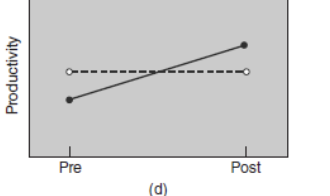quasi experimental designs and applied research
1/19
There's no tags or description
Looks like no tags are added yet.
Name | Mastery | Learn | Test | Matching | Spaced |
|---|
No study sessions yet.
20 Terms
dual functions of applied research
Solve real-world problems
Increases basic knowledge, evaluates theory
applied research in history
trained in basic research, felt pressures to produce “relevance”
ethical dilemmas in applied research
consent, privacy, potential coercion
trade-off between internal and external validity
internal validity may suffer
Problems unique to between-subjects designs
Can be difficult to create equivalent groups
Problems unique to within-subjects designs
Uncontrolled order effects, attrition
quasi experimental design
No causal conclusions, less than complete control, no random assignment
Non-equivalent control group designs
Typically (but not necessarily) include pretests and posttests
Random assignment to groups not possible for practical reasons
example of nonequivalent control groups design
Two factories, one in Pittsburgh and one in Cleveland
Implement Flex time (work 8 hours but whenever u want) in Pittsburgh

regression to the mean and matching
Match based on pretest may produce
Experimental group that scores higher than population on pretest
Control group that scores lower than population on pretest
Both groups may regress to mean on posttest, masking any real change due to treatment
Nonequivalent control group designs without pretests
Ruled out alternative explanation that those in California would always have more earthquake nightmares
interrupted time series design
Able to see natural fluctuations and why they happen
Useful for evaluating overall trends
variations on basic time series design
add a control group, add a switching replication, Add a second DV, not expected to be influenced by the program
program evaluation
Started in the 1960s to evaluate social programs; does the need exist, does it function, what is the outcome, is it worth the cost
need analysis
Census data
Surveys for available resources (any repeats?)
Surveys of potential users
Key informants, focus groups, community forums
formative evaluation
Evaluating program while in progress
Implemented as planned?
Program audit
Pilot study
summative evaluation
Program effectiveness
More threatening than formative evaluation
Use of quasi-experimental designs
Failure to reject H0 can be useful outcome
New programs have to prove themselves
cost analysis
Two equally effective programs, but may differ in costs
Most cost-effective wins
qualitative analysis
Quantitative data if often supplemented with qualitative data in various steps of program evaluation
ethics and program evaluation
Consent issues → special populations
Confidentiality issues
Perceived injustice (Participant crosstalk: control group perceives themselves at a disadvantage)
stakeholder conflicts